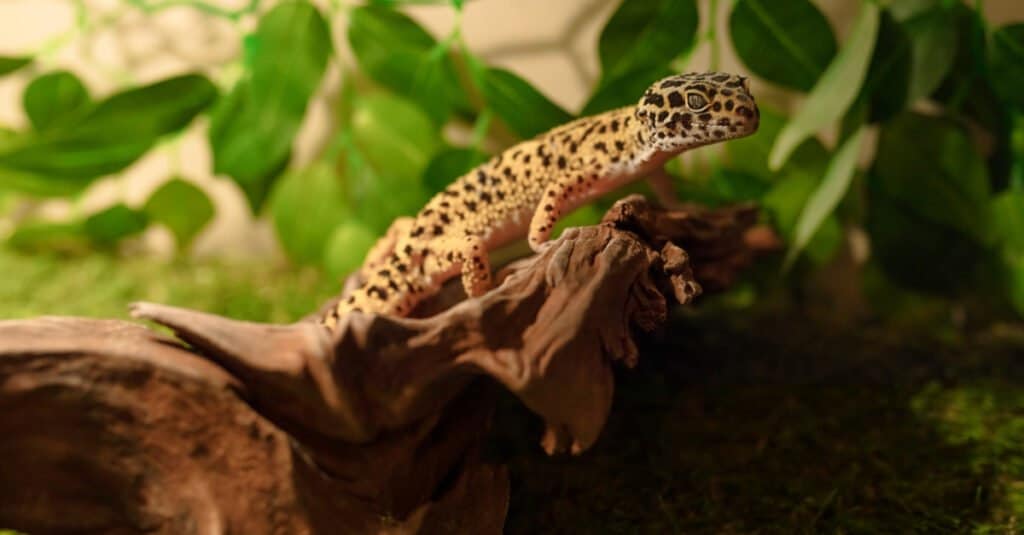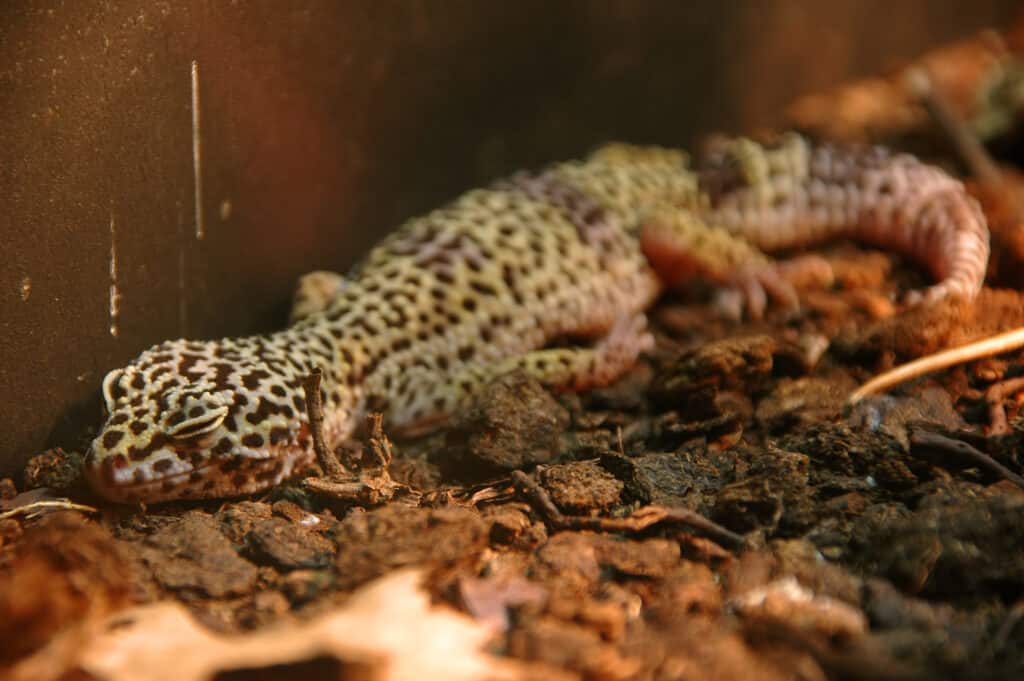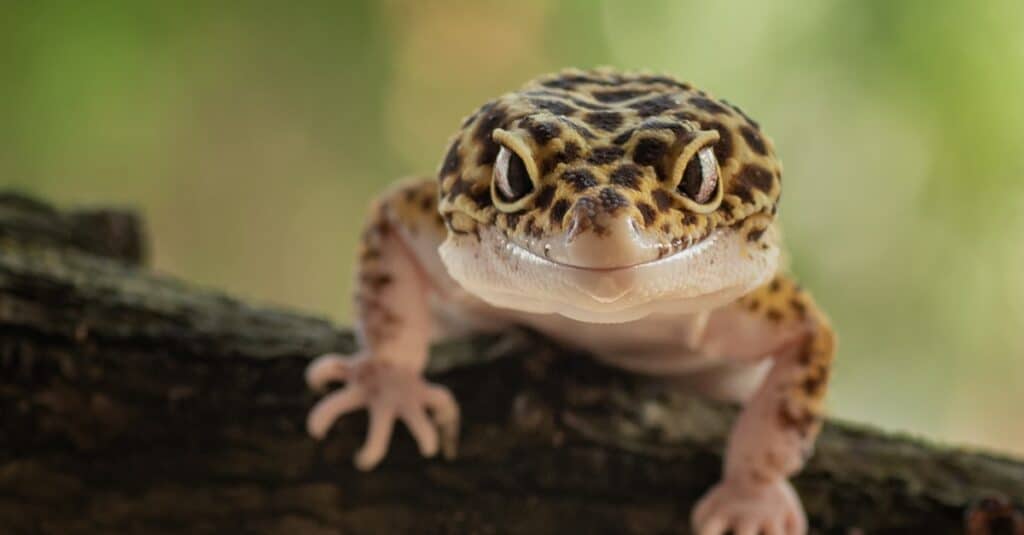Leopard geckos live in the wild and are a common pet for many people across the globe. These reptiles are also low high maintenance and may become tame over time. As a leopard gecko owner, you should arrange their feeding times around when they are naturally most active, but when is that? We ask important questions like, are leopard geckos nocturnal or diurnal in this article. We also examine the sleep behavior of these reptiles to reveal critical information for keeping your pet happy in a domestic environment.

Elena Belodedova/Shutterstock.com
Leopard Geckos Are Crepuscular
In the wild, leopard geckos live in deserts. Deserts can be very cool at night and very hot during the day. Neither condition is ideal for leopard geckos. Because of this, dawn and dusk are suitable for leopard geckos as it is neither too hot nor too cold. It’s ideal. An additional benefit to being crepuscular is that leopard geckos can also avoid large predators such as snakes, foxes, and large reptiles by hunting at dawn and dusk.
Being crepuscular also means leopard geckos have less competition for food. Most natural leopard gecko predators tend to be either primarily nocturnal or diurnal. Thus, confining their primary activities to the twilight hours is more or less a survival mechanism for leopard geckos.
Because pet geckos are also crepuscular, owners should arrange their feeding times around their natural sleep schedule. Pet leopard geckos spend most of their day resting in hiding places and enclosures. If you rarely see a leopard gecko during the day, it’s usually not a concern. They follow their natural body clock, which is in semi-light conditions.
Sleep Behavior of Leopard Geckos
Leopard geckos spend most of the day curled up in their hide or under a shelter. They avoid regular exposure to direct sunlight like other lizards, as this is where they could fall victim to predators. So, most of the time, you might not see leopard geckos as they sleep during the day. In fact, leopard geckos sleep for 12 to 13 hours on an average day. However, throughout the night, leopard geckos are most awake and active.
Whether dry or humid, geckos sleep curled up in their shelters. But they sometimes randomly lie around their enclosures. Lying out in the open shows that they feel safe and comfortable.
However, if you notice that your leopard gecko is sleeping for more than 15 hours into the nocturnal and daylight hours, this may be a sign of health problems. This sleep behavior could be due to nutritional deficiencies, parasites, or something else that may be wrong with them.
It isn’t easy to know how active geckos are at night, so it’s best to check their behavior and health during the day. Leopard geckos are cold-blooded. Therefore, if the nights are cold, you may need to supplement the heat in their shelters.
You can install a space heater in the same room or a ceramic radiant heater above the enclosure. Ensure the ambient temperature inside the enclosure does not exceed 80 degrees Fahrenheit on the cold side, which can lead to health issues.

Ricardo A. Alves/Shutterstock.com
Ensure the Correct Lighting for Your Pet Leopard Gecko
It is essential to ensure a specific day and night cycle for your pet leopard gecko within its shelter. Owners can place the gecko enclosure in a room with plenty of natural light, which may be sufficient for their needs. However, direct sunlight will increase the temperature inside the tank. For this reason, it is critical to avoid exposure to direct sunlight as this may overheat your pet.
The Best Time To Spend Time With Your Leopard Gecko
Just because a leopard gecko’s natural behavior is crepuscular doesn’t mean there’s a lousy time to interact with your pet during the day. There’s never a wrong time to socialize with a gecko, as they rarely seem irritated when they wake up from a nap. The more you interact with a gecko, the tamer it becomes, creating a fulfilling relationship.
The best way to interact with reptiles is to encourage their natural behavior. Ways to do this can include letting them nap on you. Allowing them to rest on your body will be pleasant as they will enjoy your body heat, which they naturally seek.
Leopard geckos are not social animals. In most cases, they do not exhibit the social behavior of most other pets. This behavior means you can leave your leopard gecko alone for long periods. However, leopard geckos are not anti-social and may become accustomed to being petted and cradled.
Where Do Leopard Geckos Sleep?
Leopard geckos like to hide when they sleep, whether under tree bark, crevices in rocks, piles of leaves, or wherever they feel protected from predators. So, no matter whether your pet leopard gecko wants to take a nocturnal sleep or nap during the day, ensure it has a snug, safe place undercover to hide away.
Leopard Gecko Brumation During Winter
Brumation is the term used to describe the resting period for leopard geckos during winter, similar to hibernation. During this time, the leopard gecko shuts down its body functions to conserve energy. The leopard gecko will avoid being active during the brumation period, similar to hibernation. But leopard geckos sometimes enter brumation in the wild to wait out the cold due to a lack of resources.
However, you can keep their light cycle and feeding times constant in captivity to prevent brumation or shorten this rest period. Despite your efforts, nature can prevail, and their biological clock can take over. If this happens, they may enter brumation, which typically lasts from about September until early spring.

iStock.com/DikkyOesin
Lighting and Temperature for Pet Leopard Geckos
When you buy a pet leopard gecko, the pet shop owner will probably give you some guidelines for how to care for your pet regarding lighting, temperature, and humidity. And if they don’t, you can always use this source as a basis to guide your care of this pet.
Lighting
A light inside the tank helps regulate the day/night cycle. This light supports the gecko’s mental health and stimulates its appetite. You should provide 14 hours a day of light in summer, simulating an optimal day length. To replicate the changing seasons, reduce the light to 12 hours daily in winter. Having a light inside the tank is also valuable for the owner. Occasionally, leopard geckos come out to bask during the day. You can then watch them if there is enough illumination in the enclosure.
The sun produces three types of ultraviolet light: UVA, UVB, and UVC. UVC destroys DNA and is blocked by the earth’s atmosphere. Still, nearly every animal has evolved to rely on its two other wavelengths. Reptiles, in particular, benefit from exposure to UVA for their vision and exposure to UVB for their healthy metabolism, especially vitamin D synthesis and calcium metabolism.
Temperature
Leopard geckos, like all reptiles, need a temperature gradient within their terrarium to stay healthy. The basking surface temperature should be between 94- and 97 degrees Fahrenheit. The warm hide should have a temperature between 90- and 92 degrees Fahrenheit.
The cool end should be between 70- and 77 degrees Fahrenheit. At night, leopard geckos can withstand temperatures as low as 60 degrees Fahrenheit. Lowering the nocturnal temperature is healthier than maintaining the same heat at night and is very beneficial for the long-term health of your leopard gecko.
Humidity
Leopard geckos are desert animals that need a relatively dry environment to stay healthy. The ideal daytime humidity is between 30% and 40%, which should match the natural humidity of your home. Place the gecko in a terrarium with a canopy or equivalent ventilation to keep it dry.
That said, leopard geckos require higher humidity to shed. The most common health problem encountered by leopard geckos is molting complications. Rather than increasing humidity throughout the enclosure, which can make the gecko sick, provide a humid hide lined with a moist substrate and place it on the warm side of the tank. The moisture content of the humid hide should be 70 to 80%, which will facilitate healthy shedding.
Nocturnal vs. Diurnal: What’s The Difference?
Navigate to Nocturnal vs. Diurnal: What’s The Difference? for further information about the nocturnal and diurnal phenomenon in various living creatures.
Up Next
- Leopard Gecko Breeds: The Complete List of Leopard Gecko Morphs
- Why Do Leopard Geckos Scream?
- Male vs. Female Leopard Geckos
- Leopard Gecko Size: How Big Does a Leopard Gecko Get?
The post Are Leopard Geckos Nocturnal Or Diurnal? Their Sleep Behavior Explained appeared first on AZ Animals.
from Animal News, Facts, Rankings, and More! - AZ Animals https://ift.tt/41O9wQA